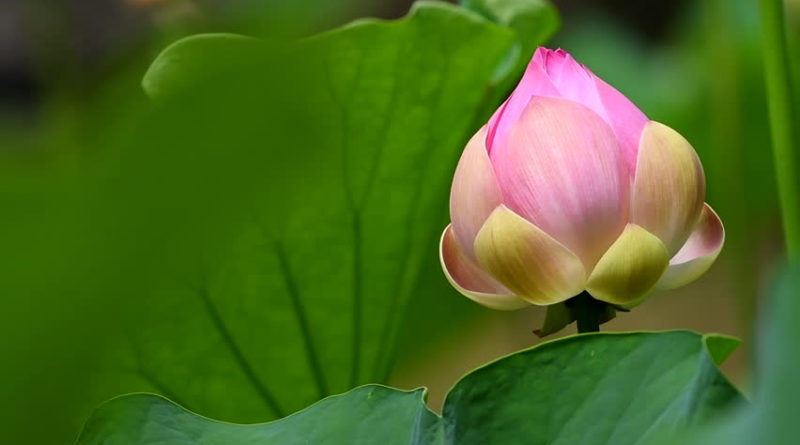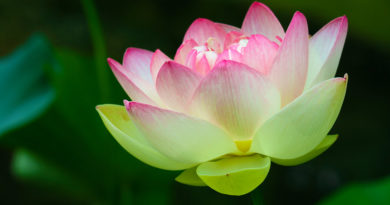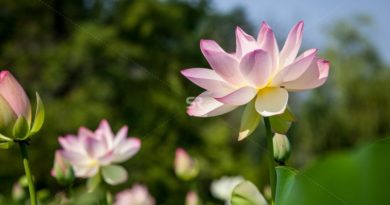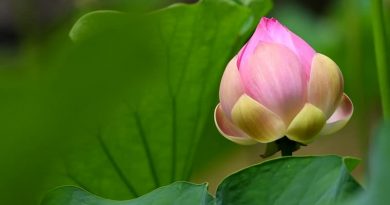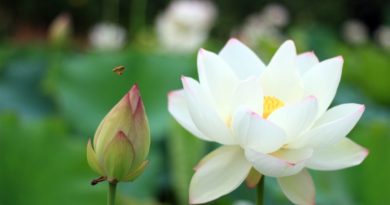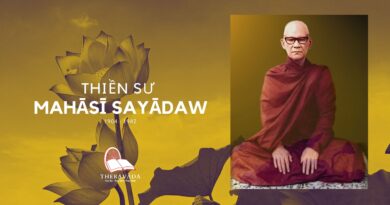DHAMMA RATANA – CHAPTER 2: SEVEN CONSTANT PROPAGATING KUSALA
DHAMMA RATANA – CHAPTER 2: SEVEN CONSTANT PROPAGATING KUSALA
The Dhamma talk will be about the benefits of offering waso robe. Every year the devotees offer waso robes to monks and also listen to dhamma talk on the benefits of waso robe offering which is a nibaddha kusala. Nibaddha kusala means constant propagating meritorious deeds which you all have gained. If one with nibaddha kusala does not attain sotapanna in this life, due to some circumstances he will be liberated from apaya in the second existence, just like a sotapan. So said the learned teachers who could comprehend the Lord’s desire. Our Benefactor Rev: Mahasi Sayadaw had composed a verse pertaining to the above statement, so that the dhamma listeners and the future laities will aspire to do nibaddha kusala which prevents suffering in apaya in the subsequent existence.
Motto: Taking Refuge in the Three Gems, observing five precepts and drawing lots.
Fortnightly dana, waso robe offering,
Donating cisterns for drinking water and monasteries building,
Donors of these seven danas,
Like sotapanna will not return to apaya.
Nibaddha Kusala of Refuge in the Three Gems
To take refuge in the Three Gems forever is a nibaddha kusala. The dhamma listeners of good parentage and students of good teachers take refuge in the Three Gems since childhood in accordance with the admonishments of good parents and good teachers.
Buddho me saranam annam natthi. For me there is none other than the Buddha to take refuge in.
Dhammo me saranam annam natthi. For me there is none other than Dhamma to take refuge in.
Sangho me saranam annam natthi. For me there is no other than Sangha to take refuge in.
Whenever you recollect you member and acknowledge that there is no other refuge than Buddha, Dhamma and Sangha, and thus propagate meritorious consciousness. Hence to take refuge in the Three Gems is a nibaddha kusala.
Nibaddha Kusala of Five Precepts
The dhamma listeners of good parentage and students of good teachers, strictly observe five precepts, according to the guidance of good parents and good teachers, just like fastening a lower garment (paso).
When there arises a chance to take life, listeners of dhamma remind themselves, “I’m not going to kill now nor never, never.” That is meritorious consciousness, hence you propagate nibaddha kusala.
Similarly, whenever there appears a chance to steal, to commit sexual misconduct, to tell lies, causing unhappiness and destruction to others, to take intoxicants, you reprimand yourself by saying “I’m not going to steal; I’m not going to commit sexual misconduct; I’m not going to tell lies; I’m not going to drink”. By doing so, you always gain nibaddha kusala.
It is of utmost importance for the Buddhists not to tell lies. The listeners of dhamma also should take a good care not to infringe the precept of lying; as there are many ways of telling lies intentionally or unintentionally. Day in and day out you talk for various reasons; whereupon if you are not mindful, you would not have nibaddha kusala. Therefore you will inevitably suffer in apaya. People used to exaggerate; for example to praise a person more than he deserves; or to be-little or blame a person though he is not that bad. Exaggeration, in a way, is just lying, therefore you all must be careful not to breach the precept by exaggeration. Then only you will be liberated from apaya. Observation of five precepts, therefore is a constant propagating kusala forbidding suffering in apaya in the next existence.
Nibaddha kusala of Drawing lots
In the Buddha’s life-time, there were 500 or 1000 more monks in each monastery. With faith in dhamma, pious people would like to offer alms to each and every monk. Due to financial limitation, however, they could offer to a few only. Thereupon they approached the elder monks and requested to let them offer alms to 5 or 10 monks only by drawing lots. They invited and brought the monks home and offered alms-food, robes and other requisites every week, every month and every year. After offering in that week, in that month and in that year they always thought about the offering for the next week, next month and next year. Thus they propagate merits all the time. Therefore offering by drawing lots also is a nibaddha kusala.
Nibaddha kusala of Fortnightly alms-food offering
During the Buddha’s life-time, righteous laities usually offered alms-food to monks every full-moon day and every last waning day of a month. Likewise, now-a-days in some places there is this practice of alms-food offering to two, three or as many monks as of fortnightly they could afford. After offering on the full-moon day, they are again busy with wholesome mind, preparing for the next offering on the last waning day of the same month. At the same time, they delight in reflecting, “We are going to offer alms-food on the coming last waning day of this month.” Thereupon the fortnightly alms offering is a nibaddha kusala, meaning that one develops a meritorious disposition continuously.
Nibaddha kusala of Waso robe offering
Waso robe offering is celebrated every year. Further more the listeners of dhamma always enjoy the thought to offer Waso robe for the next year. Thus they develop wholesome mind all the time. Monks receiving the robes also strive hard during the lent, more than before and after the lent. The student-monks try conscientiously to finish learning at least a volume or a book of scriptures. In the same manner, the meditating monks practise diligently to gain the noble dhamma during the lent. Whenever the monks wear the waso robes, donors gain merits. How? “The waso robes, donated by us will be worn by the student-monks when they study scriptures. In the same way, the meditating monks will wear the waso robes while practising vipassana meditation” reflecting thus waso robe donors gain merits constantly. Hence waso robe offering is also a nibaddha kusala.
Nibaddha kusala of donating cisterns for drinking water
The donors of cisterns for drinking water, well, artesian well, housing for drinking pots and drinking fountains, gain merits whenever travellers, monks, noble persons and donors from all directions drink and use water from these places. How? Every time when the donors reflect or thought of how travellers, monks, noble persons, donors would enjoy by drinking and using the water from the cisterns, well, artesian wells, water pot and drinking fountain that, they have donated, they are filled with joy and wholesome mind. Thereupon they gain merit all the time and that is why the donation of cisterns, surface wells, artesian wells, drinking water pots and water fountains, is a nibaddha kusala.
Nibaddha kusala of building Monasteries
The donors of monastery for teaching scriptures are happy and gain merits whenever sayadaws lecture scriptures, give dhamma talks and study dhamma in the monasteries donated by them. If the monastery is donated to be used as a meditation centre, the thought of monks, yogi and noble persons, practising meditation in his monastery will propagate much merit in him. The offering of monasteries is a nibaddha kusala since it promotes constant merits in the donor’s mind.
The athakatha teachers who explicitly conceive the Lord’s concept of teaching, have explained that those who have done these seven nibaddha kusalas, similar to sotapan, and will be saved from apaya in the immediate existence though they may not be a sotapan in this very life.
The most Rev: Mahasi Sayadaw had composed the following verse relating to the seven nibaddha kusala, so as the listeners of dhamma and the future laities may have distinct idea of nibaddha kusalas and gain merit by undertaking them. Let us repeat it.
Motto: Taking Refuge in the Three Gems, observing five precepts and drawing lots.
Fortnightly dana, waso robe offering,
Donating cisterns for drinking water and monasteries building,
Donors of these seven danas,
Like sotapanna will not return to apaya.
Though it is likely that those who have nibaddha kusala will not suffer in apaya in the second and may be in the third existence, it is not certain for the fourth and fifth existence. That is the reason why you all are constantly practising mindfulness meditation, the only way to close the door to apaya. If circumstances are favourable, you can be completely liberated from apaya in this very life. In other words, it is the forever end of suffering in apaya. So said the Buddha and guaranteed as a prelude to the Maha Satipatthana Sutta.
“There are four mindfulness dhamma namely, contemplation of body, that of feeling, that of consciousness and that of dhamma. The 4 foundations of mindfulness practice is the only way which can save one from apaya and simultaneously results in the attainment of ariya magga. There are no other branches, this is the one and only one way for the realization of nibbana, the end of all sufferings,” preached the Buddha. The four mindfulness meditation which the listeners of dhamma are practising, is the one and only way to close the door of apaya and to attain the sublime magga. Indeed, there is no other way to do so. It is also the one and only one path to nibbana which is free from all sufferings. You always aspire for it, every time you carry out the meritorious deeds. This is the reason why you should practise the mindfulness meditation doubtlessly.
Motto: If you wish to gain noble magga practise satipatthana.
If you wish to attain the noble magga which can put the end to sufferings in apaya, practise mindfulness meditation.
You will attain it one day, according to your perfection and the strength of concentration.
Motto: If you wish to realize Nibbana practise satipatthana
Since childhood, under the guidance of good parents and good teachers, you all have aspired for the happiness of nibbana whenever you do meritorious deeds. The 4 mindfulness meditation which you are practising now, is the one and only one path with no other branches, to realize and attain nibbana. This is what the Enlightened One guaranteed before teaching the Maha Satipatthana Sutta.
Well known physicians went to all directions announcing that their medicines were so good that they can cure all kinds of diseases. In the same manner the Buddha guaranteed that the Four foundations of mindfulness meditation can promote the attainment of ariya magga which ends the sufferings in apya and which also leads to realization of nibbana. This is the announcement the Lord made before teaching the Maha Satipatthana Sutta.
Listeners of dhamma, do you believe it? I’m certain that you are practising the mindfulness meditation as you have faith in it.
One cannot attain ariya magga nor realize the nibbana by physical exercises, by elocution nor by reading. Then what is the mean or way to attain ariya magga and nibbana? It is no other than the work of conscious mind which is not easy for the ordinary persons with less perfection; as it is profound and subtle. Some offer dana, some observe sila and some practise samatha meditation in order to reach nibbana. Is it possible to attain nibbana by means of dana, sila and samatha? No, never. There is no other way or branch to attain nibbana other than mindfulness meditation. If one sincerely and truly wants to attain nibbana, the most reliable way is to practise mindfulness meditation.
Vipassana meditation means controlling of mind, which is not an easy task. Yogi met with a lot of difficulties at the beginning of practice. When the mind is subdued by the 4 foundations of mindfulness meditation, it becomes subtle and cultured. Then it is an asset for the attainment of ariya magga and realization of nirvana which you always aspired for. Thus the Lord has taught: Contemplation is the work of conscious mind which is hard to control or restrain, for it delights in wandering off. The mindfulness meditation is difficult, profound and subtle as the practising yogi has experienced at the beginning.
It is not an easy task to manage the mind for the reason that it usually delights in any sense-objects it comes into contact. It is also hard to obstruct it. Mind swiftly appears and dissolves; it may be happy now, but distressed in the next moment; it has faith in dhamma now, however not in the next minute. Hence it is uncontrollable.
The mind likes to dwell upon are mostly unwholesome ones, such as craving, attachment, anger, hatred, etc. It never delights in wholesome dhamma like Buddha, Dhamma and Sangha, and nama and rupa. Therefore with much difficulties yogi endeavour to settle his mind on these wholesome dhammas. If the mind is not restrained, it always enjoys in the unwholesome sense-objects.
The listeners of dhamma under the guidance of good parents and good teachers, since childhood, they could control their mind. Whereupon they now can delight in dhamma. It is the nature of mind to dwell upon unwholesome sense-objects and to wander off on its own accord. Hence to control the mind is a difficult task. It is the nature of the conscious mind but not that of the individuals.
This very mind when subdued and cultured by the mindfulness meditation, according to the Buddha’s instruction, will send one to the most aspired nibbana; so said the Buddha. Many Elders and noble monks have attained the noble dhamma, that is magga, phala and nibbana by following the Buddha’s guidance. I believe that is why the listeners of dhamma talk sincerely practise the mindfulness meditation.
Though it is difficult at the beginning of meditation practice, you all have experienced that it is not so in the middle and later stages of practice. This is again due to the subdued mind which enables yogi to attain nibbana. Our Benefactor Rev: Mahasi Sayadaw had composed a verse on the nature of the mind, wishing the dhamma listeners to practise with faith and sincerity. Thereupon they could apprehend the nature of the mind, that is once it is tamed, the gross mind could lead one to nirvana.
Motto: Hard to restrain, swift and wandering
This harsh, gross consciousness goes roving
When subdued by observation and mindfulness
It becomes mild, subtle and gives one happiness
After listening to this dhamma talk on the benefits of waso robe offering and the seven constant propagating kusalas, may you all be able to practise in compliance to the Buddha’s teaching. With diligent contemplation, may you all immediately realize your most aspired nirvana, the end of all sufferings by practising with ease.

